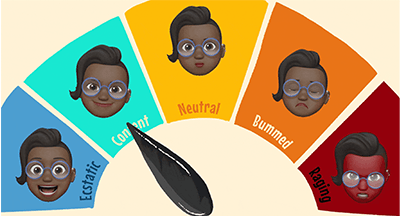
How do we build a healthy skepticism to navigate the Internet’s endless offerings of questionable research, hasty summaries, and opinions masquerading as fact? Most importantly, how do we model those strategies for students?
1) Fact Literacy
Don’t let quick changes in media trends blend the lines. Facts, opinions, and beliefs may be presented alongside one another, but they are not interchangeable terms.Facts are verifiable statements validated through science, historical observation, and other primary sources. They strengthen an argument by providing evidence, but by their nature do not carry a bias. Facts need context to have value.
Opinions are reasonable judgments based on available evidence, though they cannot be verified like facts. They don’t (or shouldn’t) hold as much weight in an argument. Opinions are changeable once someone considers different evidence, and opinions can betray a bias.
Beliefs are based on culture, faith, morals, or values rather than fact. These statements may be more emotionally charged and biased than opinions.
Core beliefs are the deepest beliefs there are. These are very hard to change and invoke the strongest emotional response when someone tries.
Legitimate publishers are more likely to place indicators on their opinion pieces. Less scrupulous publishers may present opinions (or even beliefs) as facts, which makes learning to decode these different statements even more important. Headlines are not guaranteed to be a strong source of facts, since they are often written to get people to click—not always to inform or summarize the facts in the story. Always read the entire story to get the facts.
Red flags:
🚩 First-person language (“I,” “me,” “my”)
🚩 Inflammatory statements
🚩 Rough or attacking language not quoted from a person
🚩 Lack of supporting citations
🚩 Outwardly displaying or hinting at bias
2) Source Literacy
After reading the whole article thoroughly (not just the headline), peruse some of the sources it provides. Do they truly support the claim, or are they simply links to sites related to the idea? Is any of the evidence actually an opinion or belief masquerading as fact? Keep an eye out for spelling and grammatical errors—of course, typos occasionally slip by editors’ eyes, but most credible sources will have a firm grasp on their language quality.Once readers understand different levels of bias, they can conduct some opposition research. Choose an article about the same topic from a different news source to see the evidence presented from a different, ideally opposite, angle. If in doubt, check out the publication's about page and the author’s bio to detect any hidden biases.
One of the quickest ways to determine a story’s validity is to consult a fact-checking website. There are several—including Politifact, ProPublica, and Snopes, to name a few well-known or award-winning options. This is just the tip of the verification iceberg, though.
Red flags:
🚩 Bias stated or implied in author and about us pages
🚩 Posting clickbait to boost ratings
🚩 Untrustworthy, unrelated, or biased sources (or no sources at all)
🚩 Failing a fact check
🚩 Being unable to find other sources reporting on the claim to verify it (too good to be true)
🚩 Lots of editing errors
🚩 Broken links
3) Research Literacy
It can be easy to take the blanket term “research” for granted, but not all studies are created equal.Commercial bias may lead companies to produce faulty research to support their product. Here’s a few things which may betray a biased study:
- Sample size (N): A smaller sample size makes a study harder to apply to the general population. With more subjects, there’s more of a cross-section of people. If the study is randomized, even better—leaving things to chance will reduce the instances of bias impeding the study’s results.
- Who conducted the research?: Take a deep dive into the organization behind the research. What are their affiliations? Have any of the researchers ever held positions with the company funding the research?
- Who paid?: Follow the money to uncover any funding biases masquerading behind layers of organizations.
Red flags:
🚩 Small sample size
🚩 Researchers paid by or otherwise sponsored by companies
🚩 No clear link to the actual study’s results
4) Advertising Literacy
Advertorials are editorials written by companies and submitted to publications, and they’re not new—newspapers were printing interesting articles which ended up as product pitches dating back to the early 1900s. Today, native advertising—slipping ads into a typical article feed—creates similar confusion between news and advertising.Algorithms and other methods of tracking use browsing history to help suggest interesting topics for readers. Bias helps companies increase sales by leveraging the articles readers consume and share, then using those trends to guide native advertising.
**Editor's note: We've always tried to be transparent about the fact that Advancing K12 is the content brand for Skyward. When done well, content marketing is never about trying to manipulate or steer readers in a certain way—it should be about providing value to the audience. Your readership boosts the credibility of our website in the eyes of search engines, with the natural result being more traffic everywhere (including the product-heavy pages).
Red flags:
🚩 Anything sponsored by a company
🚩 News stories link to retail sites
🚩 Paid "consultants" as authors
5) Misinformation Literacy
What do people have to gain from the spread of misinformation?Return on investment: For companies, it’s all about the bottom line. If a company can control the narrative and the messaging readers consume, it may be able to skew sales in a positive light. This includes boosting positive opinion and cushioning the blow of negative coverage.
Division: By exploiting specific biases, people may work to deepen political divides, create smokescreens, and generally draw the collective attention away or toward a specific narrative. People who take part in these campaigns are called trolls.
At times, existing algorithms may help these campaigns along. All the more reason to question everything.
Red flags:
🚩 Extreme bias
🚩 "News" sponsored by companies
🚩 Lack of credible sources
6) Psychological Bias Literacy
Don’t be fooled by inner biases.Confirmation bias refers to the tendency to interpret new evidence as confirmation of existing beliefs. Help fight this bias by conducting opposition research and learning to listen to understand, instead of automatically forming a rebuttal.
The backfire effect deals more with the intersection of facts and strongly held beliefs. When confronted with facts that challenge strongly held beliefs, people tend to hold even harder to their original belief, instead of changing it.
Red flags:
🚩 A desire to limit the opposing viewpoints encountered
🚩 Never encountering an opposing viewpoint organically (referred to as an echo chamber)
🚩 Experiencing strong emotional reactions to new information
7) Listening Literacy
The best defense for being swayed by misleading news is to master the literacies outlined here, plus one: the ability to listen thoughtfully to multiple viewpoints.- Stay calm. It’s okay to feel uncomfortable—it’s what brains are biologically geared to do. The amygdala triggers a response when deeply held opinions are challenged.
- Listen to learn. Instead of arguing immediately, digest the information and do some follow-up research. Form a rebuttal after calming down.
- Actually learn. One of two things will probably happen: Something will inspire you to seek more evidence, and your opinion may change. Or, your original opinion may be upheld. Both are okay.

It’s always a good idea to inspect the way we interact with information. These strategies don’t just create choosy readers —they build open-minded people ready to approach the world. Armed with critical thinking and a healthy skepticism, we can all be primed to contribute to a robust, less divisive culture without inadvertently contributing to the spread of misinformation.
News literacy is not a course in and of itself. It's an interdisciplinary challenge for all of us as business professionals, educators, and digital citizens. It's time we challenged ourselves to model the behavior we wish to see from the next generation while sharing the lessons we've learned along the way.
Follow-up resource: 10 Literacies in K12
Kids are learning way more than the "three R's." Find out the Top 10 Literacies in Education Today.WHAT'S NEXT FOR YOUR EDTECH? The right combo of tools & support retains staff and serves students better. We'd love to help. Visit skyward.com/get-started to learn more.

|
Erin Werra Blogger, Researcher, and Edvocate |
Erin Werra is a content writer and strategist at Skyward’s Advancing K12 blog. Her writing about K12 edtech, data, security, social-emotional learning, and leadership has appeared in THE Journal, District Administration, eSchool News, and more. She enjoys puzzling over details to make K12 edtech info accessible for all. Outside of edtech, she’s waxing poetic about motherhood, personality traits, and self-growth.




